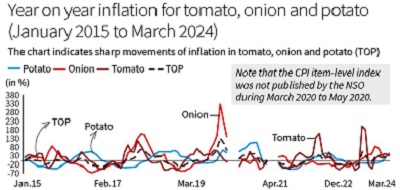Context
Inflation is a key economic indicator, reflecting changes in the general price level and cost of living within a country. In India, the Consumer Price Index (CPI) is utilized to measure price inflation, primarily based on the Laspeyre’s price index, which assesses the cost of living within the economy. The CPI basket, comprising 299 items, includes vegetables which hold a weight of 6.04% in the total basket. Among these vegetables, three specific ones — tomato, onion, and potato (collectively referred to as TOP) — hold a weightage of 2.2% in the overall CPI basket for an average Indian household. These three vegetables have historically had a significant impact on both food and beverages inflation and the headline CPI figures.
The Role of TOP in CPI
The significance of the TOP group extends beyond its numerical representation. These vegetables, tomato, onion, and potato, are staples in the Indian diet and play a critical role in influencing inflation. According to the CPI basket classification, the TOP group constitutes 3.6% of the total consumption basket in urban areas and 5% in rural India for the bottom 5% of the consumption classes, respectively. This indicates the essential nature of these vegetables in the daily consumption of households across various economic strata.
In the fiscal year 2023-24, vegetable prices in India surged by approximately 15% year-on-year. The prices of vegetables have shown significant volatility, with notable shifts from a decline of 0.7% in June to a dramatic increase of 37.4% in July. Although vegetables only account for 6% of the total CPI basket, their contribution to inflation was as high as 30% in February and March 2024. Specifically, tomato prices saw a staggering rise of 202% in July 2023, contributing to 18.1% of the total headline inflation despite their weight being only 0.6% in the CPI basket. During the same month, vegetables contributed 31.9% to the headline inflation, with the TOP group alone accounting for 17.2%.
Price Volatility
A notable characteristic of the TOP group is its price volatility. The coefficient of variation (CoV) of inflation is a key measure of this volatility. For the period from January 2015 to March 2024, the inflation volatility of TOP, as measured by the CoV, stands at 5.2. This is significantly higher than the volatility of the broader vegetables sub-group (CoV=3.0), the food group (CoV=0.6), and the headline inflation (CoV=0.3). This analysis indicates that the TOP group's CoV surpasses not only the food and headline inflation groups but also the overall vegetables sub-group. This high volatility underscores the sensitivity of these commodities to market forces, weather fluctuations, and supply chain dynamics.
|
Coefficient of variation (CoV) The coefficient of variation (CoV) for inflation measures the relative variability of inflation rates. Calculated as the standard deviation divided by the mean inflation rate, multiplied by 100, it indicates the extent of price volatility. Higher CoV values denote greater inflation instability. |
The inflation trend for tomato, onion, and potato, as well as the constructed TOP group, has remained highly volatile. The inflation rate for the TOP sub-group has ranged dramatically, from a minimum value of -36.6% in September 2021 to a peak of 132.0% in December 2019. These figures illustrate the extent of price fluctuations for these essential vegetables, highlighting the need for more stable and predictable pricing mechanisms.
Impact on Farmers
The volatility and importance of the TOP group in shaping inflation trends emphasize the need for effective policy interventions and a nuanced understanding of agricultural supply chains. These crops are perishable and are subject to various biotic and abiotic stresses. As these crops do not have a Minimum Support Price (MSP) and are predominantly sold to private traders by farmers, the volatility in prices can be detrimental to farmers, the majority of whom are net buyers of these crops. This situation necessitates solutions to reduce the price volatility for these crops.
One potential solution is overhauling agricultural value chains and improving cold storage facilities. Better prices for farmers could incentivize the production of these crops, while increased profitability in cultivation could be achieved by reducing the high input prices of fertilizers and pesticides used in their production. These measures would help stabilize the market and provide a more predictable income for farmers, thereby reducing the negative impact of price volatility on their livelihoods.
Policy Interventions
The abrupt changes in policies, such as lifting export bans on onions ahead of elections, illustrate the use of short-term measures to address price volatility. These measures often fail to address the underlying issues and demands of farmers. For instance, the memorable Kisan Long March from Nashik to Mumbai in March 2023 and ongoing protests by farmers have repeatedly raised the demand for Minimum Support Prices for onions. Despite these persistent demands, the government continues to ignore the need for such support mechanisms.
Implementing a Minimum Support Price for these crops would provide a safety net for farmers, ensuring they receive a fair price for their produce even during periods of high volatility. Additionally, improving infrastructure for storage and transportation, such as developing more cold storage facilities, would help in preserving the quality of produce and reducing post-harvest losses. These measures would contribute to stabilizing prices and reducing the overall volatility in the market.
Conclusion
In conclusion, the significant impact of tomato, onion, and potato (TOP) on India's CPI and overall inflation trends underscores the need for comprehensive policy interventions. The high volatility in prices of these essential vegetables not only affects inflation figures but also has a profound impact on farmers and consumers alike. To address this issue, there is a need for a combination of short-term and long-term measures, including the implementation of Minimum Support Prices, improvement in storage infrastructure, and reduction of input costs for farmers. By addressing these challenges, the government can help stabilize prices, ensure fair incomes for farmers, and ultimately contribute to the overall economic stability of the country.
|
Probable Questions for UPSC Mains Exam
|
Source – The Hindu







